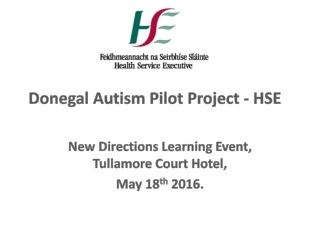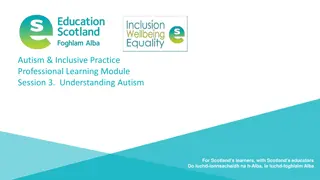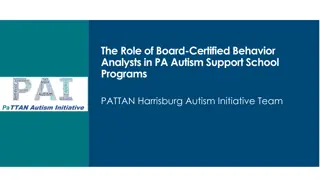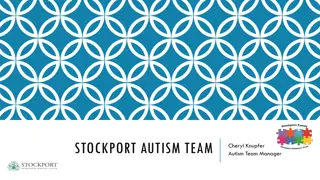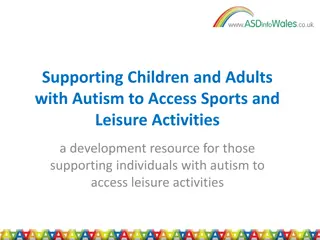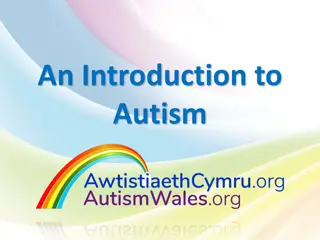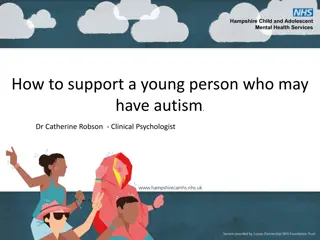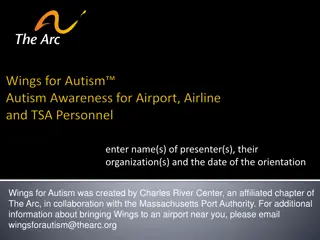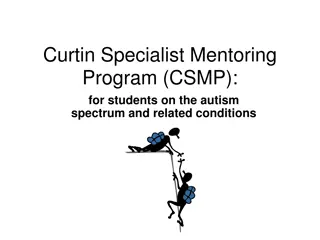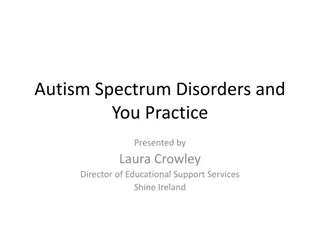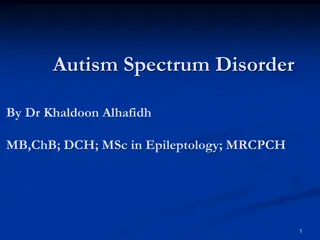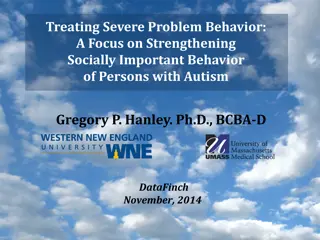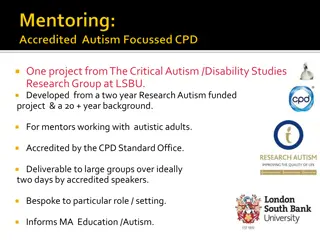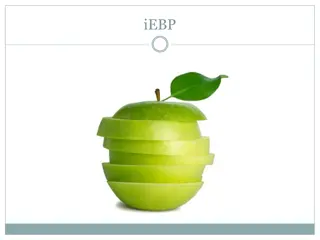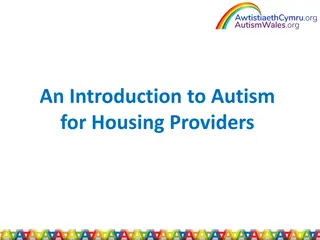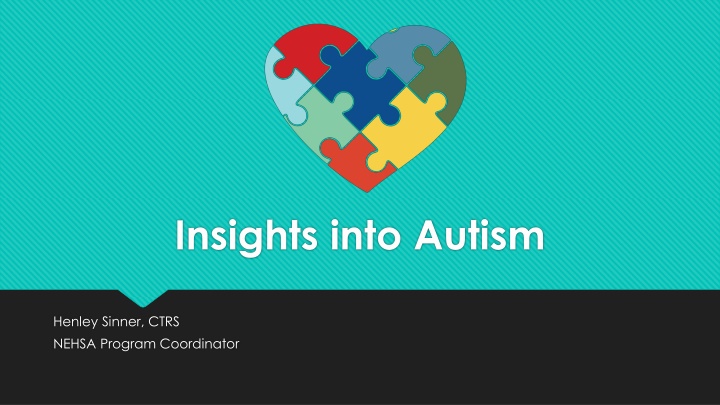
Insights into Autism Spectrum Disorder and Person-First Language
Explore the broad range of Autism Spectrum Disorder (ASD), including its symptoms, diagnosis criteria, and the importance of utilizing Person-First Language (PFL) for respectful communication. Gain valuable insights into understanding and supporting individuals with ASD.
Uploaded on | 1 Views
Download Presentation

Please find below an Image/Link to download the presentation.
The content on the website is provided AS IS for your information and personal use only. It may not be sold, licensed, or shared on other websites without obtaining consent from the author. If you encounter any issues during the download, it is possible that the publisher has removed the file from their server.
You are allowed to download the files provided on this website for personal or commercial use, subject to the condition that they are used lawfully. All files are the property of their respective owners.
The content on the website is provided AS IS for your information and personal use only. It may not be sold, licensed, or shared on other websites without obtaining consent from the author.
E N D
Presentation Transcript
Insights into Autism Henley Sinner, CTRS NEHSA Program Coordinator
First, Lets Talk About Person-First Language! Recent movement in Recreation Therapy and Adaptive Sports to utilize strengths-based approach in teaching as well as Person First Language (PFL). PFL is about respect and dignity Do your best to keep up with updated terms Please do your best as instructors to be respectful of individuals preferred pronouns If you are unsure, use they or them! I messed up and used the wrong term, what now? You may not even have to address it, just use the correct term next time! Admit you are learning and are trying to get it right if it should be addressed.
What is Autism? Autism or Autism Spectrum Disorder (ASD) Broad range of conditions characterized by challenges with social skills, repetitive behaviors, speech, and nonverbal communication. ASD affects approximately 1 in 54 US children (CDC, 2020) Many Subtypes of Autism (hence the Spectrum designation) May be influenced by genetic and environmental factors Individuals with autism may range from needing total support to living completely independently Common symbol for Autism Awareness is the puzzle piece as it refers to ASD s complexity
What Are the Symptoms? Social Communicative Challenges Restricted Repetitive Behaviors Diagnosed with 5 Criteria from the DSM-5
Diagnosis Criteria Persistent deficits in social communication and social interaction Deficits in social-emotional reciprocity Examples: abnormal social approach and failure of normal back-and-forth conversation, reduced sharing of interests, emotions, or affect; to failure to initiate or respond to social interactions. Deficits in nonverbal communicative behaviors used for social interaction Examples: eye contact and body language or deficits in understanding and use of gestures, total lack of facial expressions, and nonverbal communication. Deficits in developing, maintaining, and understanding relationships Examples: difficulties adjusting behavior to suit various social contexts, difficulties in sharing imaginative play or in making friends, to absence of interest in peers.
Diagnosis Criteria Restricted, repetitive patterns of behavior, interests, or activities, as manifested by at least two of the following: Stereotyped or repetitive motor movements, use of objects, or speech (e.g., simple motor stereotypies, lining up toys or flipping objects, echolalia, idiosyncratic phrases) Insistence on sameness, inflexible adherence to routines, or ritualized patterns or verbal nonverbal behavior (e.g., extreme distress at small changes, difficulties with transitions, rigid thinking patterns, greeting rituals, need to take same route or eat food every day) Highly restricted, fixated interests that are abnormal in intensity or focus (e.g, strong attachment to or preoccupation with unusual objects, excessively circumscribed or perseverative interest) Hyper- or hyporeactivity to sensory input or unusual interests in sensory aspects of the environment (e.g., apparent indifference to pain/temperature, adverse response to specific sounds or textures, excessive smelling or touching of objects, visual fascination with lights or movement)
Diagnosis Criteria Symptoms must be present in the early developmental period (but may not become fully manifest until social demands exceed limited capacities or may be masked by learned strategies in later life) Symptoms cause clinically significant impairment in social, occupational, or other important areas of current functioning These disturbances are not better explained by intellectual disability (intellectual developmental disorder) or global developmental delay. Intellectual disability and autism spectrum disorder frequently co-occur; to make comorbid diagnoses of autism spectrum disorder and intellectual disability, social communication should be below that expected for general developmental level
Sensory Issues and Sensory Overload Individuals with Autism may experience sensory issues that are either hyper- sensitive or hypo- sensitive Sights Sounds Smells Tastes Touch Balance Body Awareness (Proprioception) https://www.autismspeaks.org/sensory-issues https://www.youtube.com/watch?v=IcS2VUoe12M
Think About You! You may relate more to your athlete with Autism than you think! Everyone experiences a little bit of Autism in their every day lives Textures you don t like Scenarios that are overwhelming Scents that are too strong Mouth-feel of certain foods Hobby Fixations
Accommodations for Sensory Issues Hyper Sensitive Dimmed Lights Earplugs or headphones in noisy areas Sunglasses or Tinted Goggles for light sensitivity Reduced use of strongly scented products (perfumes, scented hand sanitizer, etc) Clothing that accommodates for texture sensitivities Hypo Sensitive Visual Supports Sensory Toys (fidget toys or chewies) Being allowed to stim Opportunities for practicing physical skills (ADAPTIVE SPORTS!!!)
When Overload Gets to be Too Much. MELTDOWNS When individuals with autism become overloaded with sensory input, fight or flight responses may kick in Fight: Yelling, Hitting, Tantrum Like Behavior Flight: Runs out of the lodge, may try to run away from the lesson What to do: Prior to the lesson start, check the athlete folder and talk with caregivers to see what kinds of support methods work best for athletes that may go into overload and how they might respond Ask about time limits! Use accommodations and supports to ensure the safety of the athlete (tip clip tethers for our runners , caregivers on the lesson, seizure belt for chairlift, etc) Make sure the area is safe, if on the slopes, try to get to the side of the hill, take off skis or board, sit down together and take a time out Determine if the lesson can continue safely, if not, end the lesson Inform NEHSA Staff and include details in lesson report (what triggered, how much time had passed, etc) Make sure you are ok afterwards!
Understanding Athletes Who Dont Use Verbal Communication Focus on the Can s not the Can t s Do they have a communication device such as a sight board or preprogrammed iPad? Do they know sign language? Usually a caregiver or teacher can show you the most important signs you may need to know! Can they communicate feeling cold or sensation? Either/Or Choices Crying and Laughing What do these signs mean for this individual?
NEHSA Lessons for Athletes with Autism Athletes with Autism may be involved in any of the disciplines we serve! Stand Up Skiing (Most Common) Snowboarding Sit Skiing Ski Bike (New last year!) What are some of the successful or unsuccessful techniques you ve used as an instructor for an athlete with Autism?
Lesson Tips and Tricks! Check in with the athlete, caregivers, teachers, and/or parents How is the athlete doing today? Have they eaten? First timers: Have they tried a helmet on before? Use direct language such as parallel and wedge, heel side and toe side Respect established schedules/routines First ______ Then _________ Have some tools with you out on the hill Communication Tools Communication Cards, Visual Story Boards, Tethers and Bungie Rewards (Truck Rides, Runs with a Teacher, etc) Tools to reframe a lesson aspect Athlete fixated on racing? Use a steering wheel to initiate turns!
Take Care of Yourself Make sure you are ready both mentally and physically for your volunteer day, on any lesson! Remember: Safety, Fun, Learn Feel empowered to speak up about concerns at any time! Before Lessons During Lessons After Lessons


